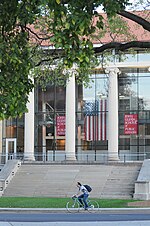Ohio Union
Buildings and structures completed in 2010Ohio State University buildingsStudent activity centers in the United StatesUniversity District (Columbus, Ohio)

The Ohio Union serves as a student activity center for students of The Ohio State University. When the Union was established in 1910, it was the first student union at a public university. The Ohio Union provides facilities for student activities, organizations/events, and campus and community interaction. Many student services and programs are housed in the union, along with dining and recreational facilities. On March 29, 2010, the current Ohio Union was opened to the public, replacing three previous unions.
Excerpt from the Wikipedia article Ohio Union (License: CC BY-SA 3.0, Authors, Images).Ohio Union
North High Street, Columbus
Geographical coordinates (GPS) Address Nearby Places Show on map
Geographical coordinates (GPS)
| Latitude | Longitude |
|---|---|
| N 39.998361 ° | E -83.00776 ° |
Address
Bibibop
North High Street 1778
43201 Columbus
Ohio, United States
Open on Google Maps








